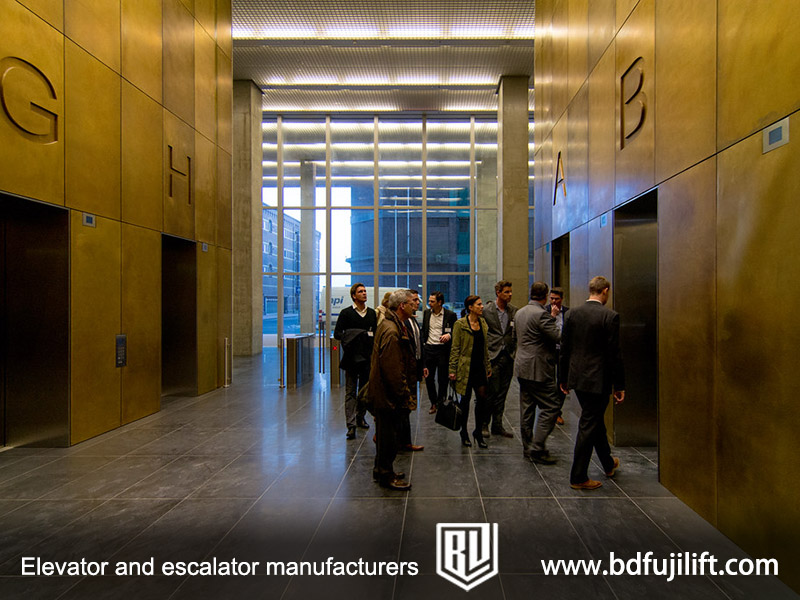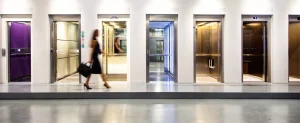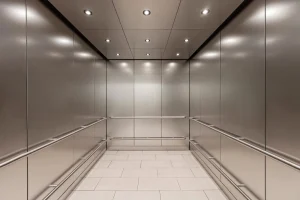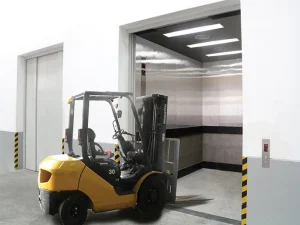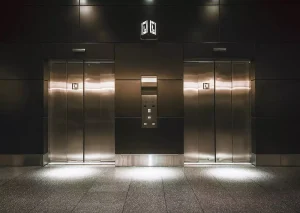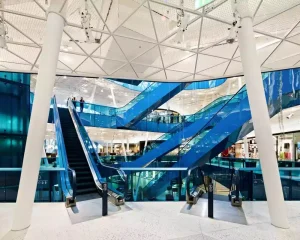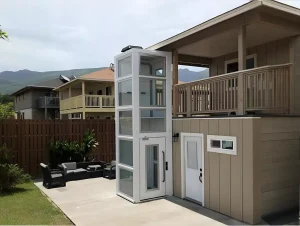When choosing an elevator, it’s important to look beyond just its appearance — local building codes and regulations also play a crucial role. Building regulations provide clear specifications for elevators in buildings. While service elevators and passenger elevators may look similar, they differ significantly in design, function, and application. Understanding these differences is key to selecting the right elevator, ensuring that the building meets all regulations while also fulfilling operational needs.
In the following sections, we’ll break down the key differences between service elevators and passenger elevators and guide you in choosing the most suitable elevator type based on your specific business needs.
Main Differences Between Service Elevators and Passenger Elevators
Service and passenger elevators differ greatly in design and function. They each serve different purposes and are adapted to different working environments. Below are the defining features of both:
Service Elevator Features:
Carrying Capacity: Service elevators are typically designed to carry heavier loads. For instance, service elevators in hospitals are built to transport beds and large medical equipment, requiring ample space and load-bearing capacity. Some large service elevators can carry over two tons of cargo, which is necessary for high-load, high-use scenarios.
Space Design: Service elevators often feature larger cargo compartments, and their interiors can be customized to accommodate items such as medical equipment, furniture, or bulk goods. Their design ensures enough space for smooth and safe transportation of goods, preventing damage from overloading or inadequate space.
Durability: Service elevators operate in high-load, high-frequency environments, so they must prioritize durability and stability. For example, in factories or warehouses, these elevators must perform consistently over time while handling heavy-duty tasks.
Passenger Elevator Features:
Carrying Capacity: Passenger elevators are intended for transporting people, with a load capacity typically ranging between 800 kg and 1 ton, which is sufficient for daily passenger needs in most buildings. Compared to service elevators, passenger elevators are designed with a focus on comfort and aesthetics.
Space Design: Passenger elevators tend to have smaller spaces, optimized for passenger comfort and efficient flow. They are designed to maximize space usage and create a pleasant ride experience. Compared to service elevators, passenger elevators have smaller doorways and cargo compartments, focusing on the needs of passengers rather than goods.
Comfort: The design of passenger elevators takes into account not only the spaciousness and flow of the space but also the comfort of passengers. This includes temperature control, noise insulation, and other features to ensure a quiet and comfortable experience.
Which One is More Suitable for You, Service Elevator or Passenger Elevator?
When choosing an elevator, it’s essential to understand the differing needs and applications in various environments. Below, we analyze typical selection criteria to help you make the best decision based on your business needs.
Hotels or Restaurants
In the catering industry, such as hotels and restaurants, elevators are not only used to transport food ingredients but also to carry kitchen equipment and tableware. Since the catering industry frequently handles items, service elevators are the first choice because they offer the following advantages:
- Ability to carry large and heavy items like food and equipment
- Durability for high-frequency use, adapting to the daily rhythm of catering operations
- Easy to clean, meeting strict hygiene standards for food transport
Some regions require food transportation to be separate from passenger flow, further promoting the use of service elevators.
Hospitals or Healthcare Institutions
In medical environments, the key elevator selection criteria are stability, space, and safety. Whether an elevator can carry beds and transport medical staff and equipment simultaneously is crucial to emergency treatment efficiency and patient comfort.
Common requirements for hospital elevators include:
- Wider doors for easy access to beds
- Multi-floor scheduling control systems (e.g., ICU directly to the emergency room)
- Antibacterial and corrosion-resistant inner wall materials
- Emergency backup power supply.
Since hospital elevators need to accommodate beds, medical equipment, and pharmaceuticals, using standard passenger elevators is not recommended. Not only do they lack the required features, but using them may also pose legal compliance risks in emergencies.
Office Buildings, Shopping Malls
In office buildings and commercial spaces, the primary elevator requirement is efficient movement of people and goods. In these settings, both passenger and service elevators are often needed:
Passenger elevators primarily transport people, focusing on comfort and speed in design
Service elevators carry office equipment, documents, and bulk items, reducing disruption to passenger flow.
In such buildings, local regulations may require the installation of multiple elevators to meet various usage requirements, ensuring safety and efficiency.
Warehouses and Logistics Centers
In logistics centers, warehouses, or factory buildings, the importance of elevators shifts from mere “convenience” to “capacity guarantee.” In these high-load, high-frequency environments, elevators must meet the following conditions:
- Load capacities exceeding 2 tons, with some reaching 5 tons
- Stable operation with smooth starts and stops to prevent damage to goods
- Industrial-grade features such as non-slip floors and anti-collision corner guards
Passenger elevators are typically not considered for use in these environments unless dedicated to management personnel and serving a secondary role.
Product Difference Table Between Service Elevators and Passenger Elevators
To help you better compare the differences between service elevators and passenger elevators, we’ve compiled a table that highlights the key differences:
| Feature | Service Elevator | Passenger Elevator |
|---|---|---|
| Load Capacity | Suitable for heavy loads, typically over 2 tons | Primarily for passengers, load capacity typically ranges from 800 kg to 1 ton |
| Design Focus | Focus on load capacity and durability, designed for high-load use | Focus on passenger comfort and smooth flow |
| Space Design | Larger cabin, capable of accommodating equipment and bulk items | Primarily designed for passenger comfort, space is smaller |
| Application Scenarios | Commercial buildings, hospitals, factories, warehouses, etc., for heavy item transport | Residential buildings, shopping malls, office buildings, etc., for passenger transport |
| Durability | Suitable for frequent high-load use, built with a sturdy structure | Suitable for low-frequency use, designed with aesthetics and comfort in mind |
Cost Comparison Between Service Elevators and Passenger Elevators
Once the elevator use scenarios are clarified, the next key consideration is cost. Elevator purchase is not just a one-time investment but the beginning of a long-term operational system. The cost differences between service elevators and passenger elevators are reflected in three key areas: initial investment, operating efficiency, and long-term maintenance.
Initial Installation Cost
Service elevators generally have higher load-bearing capacity, more spacious car sizes, and sturdier construction. As a result, their shaft size, components, and control systems are more complex, leading to overall installation costs being higher than those of passenger elevators.
For example:
- The installation cost of a 2,000 kg service elevator can be 1.3–1.5 times higher than a passenger elevator on the same floor
- If the project involves specialized requirements such as safety or cleanliness (e.g., hospitals, logistics centers), costs may increase further.
Frequency of Use and Operating Efficiency
Passenger elevators are designed to handle traffic flow focused on “people,” with faster speeds and more comfortable interiors. However, if there is substantial demand for transporting goods and equipment, relying solely on passenger elevators will reduce transportation efficiency, increase equipment wear, and affect user experience.
At this point:
- Although adding service elevators incurs a higher initial cost, they can share the transportation of goods and extend the life of passenger elevators.
- In medium and large commercial buildings, hospitals, and warehouses, the efficiency benefits of this diversion far outweigh the cost difference.
Long-term Maintenance and Replacement Costs
Due to their simple structure and focus on durability, service elevators are more stable and have a lower failure rate in long-term, high-frequency use. In contrast, frequent use of passenger elevators for heavy goods transport increases the likelihood of breakdowns, resulting in higher maintenance costs and downtime.
Additionally:
- Service elevators typically use industrial-grade materials and components, resulting in longer maintenance cycles.
- Over the same service life, the total maintenance cost of service elevators is usually lower than that of passenger elevator systems in high-frequency operation.
If the elevator’s primary role is to transport goods or manage both people and goods flow, investing in service elevators—despite their higher initial cost—provides higher returns in terms of efficiency, longevity, and maintenance. Passenger elevators are more suitable for places with light freight volume and comfort demands.
Design and Specifications of Service Elevators and Passenger Elevators
After determining the function and cost of the elevator, understanding the differences in their design and technical specifications is an important step in making further selection decisions. There are clear differences in the size, structure, material configuration, and more between service and passenger elevators, reflecting their differing service purposes and usage scenarios.
Size and Car Structure
| Item | Service Elevator | Passenger Elevator |
|---|---|---|
| Cabin Width/Depth | Common sizes: 1100 |
Typically: 1000 |
| Door Width | Usually 900~1200mm, supports trolley/bed access | Generally 700~900mm, designed for single-person entry |
| Door Opening Type | Mainly center-opening or side-opening, adaptable for various transport needs | Mainly center-opening to save space |
| Cabin Interior Layout | Focus on space utilization, avoiding protruding components that affect cargo placement | Equipped with handrails, mirrors, and button panels to enhance passenger comfort |
Carrying Capacity and Operating Parameters
- Service elevator: Standard load range of 1,000 kg to 3,000 kg, with some industrial models exceeding 5,000 kg. Speed is usually 0.5–1.0 m/s, prioritizing stability and starting torque.
- Passenger elevator: Common load capacity is 630 kg (8 people) to 1,600 kg (21 people), with faster speeds ranging from 1.0 to 2.5 m/s, designed for rapid transit in high-rise buildings.
Materials and Interior Configuration
Service elevator: Typically made of wear-resistant stainless steel, with non-slip rubber mats or industrial-grade steel plate floors. Anti-collision strips are typically installed at the corners, with no decorative materials for easier cleaning and protection against heavy items.
Passenger elevator: Interior finishes often include mirrored stainless steel, acrylic, wood panels, etc., with floors made of PVC or stone veneer. Features include lighting strips, LCD displays, and voice systems.
Service and passenger elevators each have their own strengths in terms of carrying capacity, usage scenarios, and design requirements. Service elevators excel in transporting goods, medical equipment, and high-volume items in demanding environments like warehouses, hospitals, and kitchens. Passenger elevators prioritize comfort and speed, serving office buildings, homes, and malls.
Choosing the right type of elevator depends on operational needs, not just appearance or cost. Consider the total lifecycle cost and how well the elevator aligns with your usage scenarios.
For tailored recommendations or detailed quotes, please contact BDFUJI today.
FAQ
What is the purpose of a service elevator?
Service elevators are designed to efficiently and safely transport goods, equipment, tools, or large items within a building. They are commonly used in commercial buildings, medical facilities, industrial plants, and catering venues. Their design emphasizes load-bearing capacity and durability, adapting to frequent and high-load transport needs.
What is the difference between a service elevator and a freight elevator?
Service elevators allow for the simultaneous transportation of goods and operators and focus on human-machine safety and functional integration. Freight elevators are designed strictly for transporting goods and lack safety features for carrying passengers.
Which buildings are most beneficial for installing service elevators?
Commercial buildings, warehouses, hospitals, logistics centers, and other facilities that need to frequently transport goods and equipment are best suited for service elevators.
What safety features do service elevators usually include?
Service elevators often include emergency braking systems, overload protection, emergency lighting, and automatic door protection.
What are the different types of elevator services?
Elevator types vary based on purpose and need and include traction elevators, hydraulic elevators, and machine-room-less (MRL) elevators.


